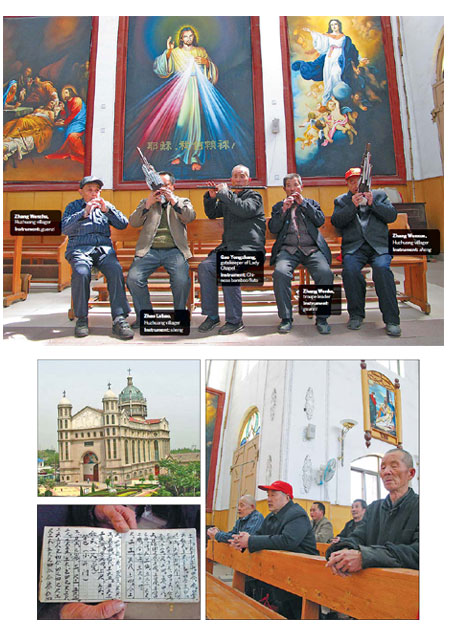Heavenly music fades out
 |
|
Clockwise from top: Five members of the Catholic music troupe at Huzhuang village perform in Immaculate Conception Church. Five villagers pray in church. Notation of the songs is recorded by gongchepu. Photos by Zhang Zixuan / China Daily The Immaculate Conception Church is a Fuzhuang landmark. Provided to China Daily |
Chinese Catholic music in Huzhuang village deserves a bigger audience. Zhang Zixuan reports in Jinan.
A beautiful church stands at the foot of the hill and a pair of steeples reaches out to the sky.
This is not a European scene, but Jianshan Hill in Huzhuang village, where the nearly 1,000 churchgoers are all farmers. The village is located about 8 km south of Pingyin county town in Jinan, Shandong province.
Gao Yongzhang is the gatekeeper of Lady Chapel, which is perched atop Jianshan Hill. Like other devout villagers, he goes to the bigger Immaculate Conception Church at the foot of the hill, for morning mass at 5 am and evening mass at 7 pm.
But on special occasions such as Christmas and Easter, Gao and a few other villagers group together to form a music troupe that plays Chinese Catholic music with traditional Chinese instruments.
"The troupe is our pipe organ," says Wang Junbao, the church's priest.
Gao says it's not clear when the customized Chinese religious music culture started. The third-generation successor of the cultural heritage was told by his teacher that it has lasted over a century.
"The songs we play are different from the original Western ones, but they are not Chinese folk songs, either," says the 77-year-old, who plays Chinese bamboo flute in the troupe. The troupe has memorized 14 songs to play for various occasions.
Other instruments include sheng, a reed wind instrument consisting of vertical pipes, guanzi, a copper pipe with holes and a reed, small cymbals, and Chinese gong chimes.
Gao's teeth are nearly all gone and his flute is not the loudest instrument. But having played the flute since he was 22, he has become the soul of the current troupe and sits in the middle. He acts as the conductor, leading every song by playing the first few notes before the other instruments join in.
Playing the guanzi are cousins Zhang Wenke and Zhang Wenzhu. The instrument has evolved from wood to tin, and now copper, so that the color blends harmoniously with the other instruments.
"We made all the guanzi ourselves," says troupe leader Zhang Wenke, with pride.
The 75-year-old encouraged his 65-year-old brother Zhang Wenxue to play the sheng in the troupe.
Reminiscing, Gao says his troupe had to practice in a 4-meter-deep cellar during the "cultural revolution" (1966-76), after a fire destroyed the church on Christmas Day, 1965. The current church was rebuilt in the 1990s.
He vividly remembers the original Immaculate Conception Church, which was built with stone and stained glass. "It was higher and more beautiful than the new one," he says.
"There used to be around 30 members and more instruments than today," recalls 80-year-old villager Zhao Qingxi, whose father Zhao Yongxian played cymbals in the troupe in the 1930s.
But today, the troupe has just 13 members and Zhang Wenke says, they hardly have a complete orchestra as not everyone is able to attend every session, especially the younger ones who work outside the village.
"But nothing stops us. We will play even if there are only three of us," he says.
Zhang adds what's urgent now is to document all the 14 songs.
"Most of us don't even keep a copy of all the songs, except Gao," says 45-year-old Zhao Lebao, the youngest in the troupe, who is also a fourth-generation successor.
"All the songs are documented by gongchepu, a traditional Chinese score sheet which uses Chinese characters to represent musical notes. We would like to document the songs using a method which is more common and user-friendly," Zhao says.
Zhang says another challenge is to find new successors.
"Neither the melody nor the performing technique is typical, and requires years of hard practice," says the 75-year-old.
But the good news is, their music is still appealing to the younger generation. "The songs are passionate and sacred to me," says Ding Xueli, a 14-year-old villager, adding that she enjoys every performance of the troupe.
In 2010, Huzhuang Chinese Catholic Music was recognized as a municipal intangible cultural heritage.
"The music combines Western and traditional Chinese music elements. It holds artistic values and is an important source for the study of the evolution of Catholic music," comments Shao Bangsen, director of Pingyin Intangible Cultural Heritage Office.
Although the troupe members have toured many churches within Shandong province, they have never been exposed to the pipe organ or any kind of Western Catholic music.
"We want to know what the original Catholic music sounds like, and we want our unique melodies to be heard by foreign Catholics as well," Gao Yongzhang, the gatekeeper, says.
Contact the writer at zhangzixuan@chinadaily.com.cn














